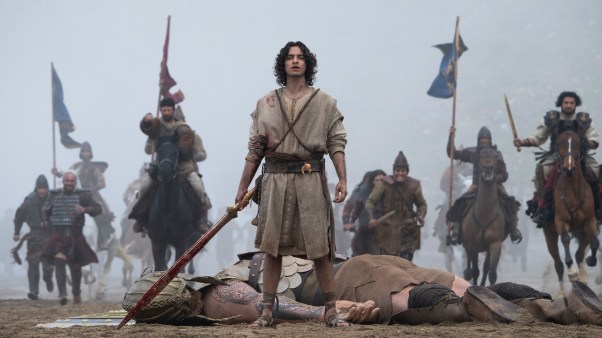To get a full historical picture of any war, it is especially helpful to see it from the perspective of the invaded. What did Muslims think of their enemies? And how devastating was their being conquered? To get answers to such questions, Christian History asked Islamic historian Dr. Hadia Dajani-Shakeel to explain. She is associate professor in the department of Middle East and Islamic Studies at the University of Toronto and co-editor of The Jihad and Its Times (Michigan, 1991).
Pope Urban II staged a massive military invasion of the Muslim East. That invasion and occupation caused the forced expulsion, conversion, or enslavement of the Muslim majority. Only a few cities in Syria remained in Muslim hands, and these became centers for Islamic resistance.
Why did Christians embark on this First Crusade? According to Muslim observers of the time, Christians aimed to expand their territory, weaken or replace Islam, avenge earlier Muslim successes in Spain and Sicily, and above all, to take Jerusalem.
Elaborating on the motives of the First Crusade, one Muslim chronicler wrote, “In the year 490 [A.D. 1097], the Franks began their march against the Sham [modern Syria, Palestine, and Lebanon]. Baldwin, their king, a kinsman of Roger the Frank, assembled a great army and sent a message to Roger saying, ‘I have assembled a great army, and now I am on my way to you. From your base, Sicily, I will march against Africa and conquer it.…’
“Roger called together his companions and consulted them about these proposals. ‘We swear by the Bible that this is good for them and for us,” they said, for “By this means these lands will be converted to Christianity.’ ”
Roger then advised Baldwin to conquer Jerusalem; “If you have decided to wage war against the Muslims, your best course will be to conquer Jerusalem, thus freeing it from their rule and winning great honor.”
The Great Loss
Muslims viewed the Christian settlements in the Sham as alien and illegitimate, established at the expense of the native population, which had been displaced or massacred. The early Christians were portrayed as ruthless, bloodthirsty, and barbaric.
Furthermore, Muslims considered the loss of Jerusalem, with its Islamic sacred shrines—the Aqsa mosque and the Dome of the Rock—as the greatest loss in their history. To profane Muslim shrines was to abuse Islam itself. The bitterness of the Muslims against defilement of their religious places, a bitterness that had been fed throughout the century, erupted in destruction of Christian images and objects when these sacred shrines were recaptured.
Some Muslim scholars interpreted the success of the First Crusade as a divine punishment against Muslims for neglecting their religious duties, and for failing to prosecute a jihad (holy war) in defense of territories God had entrusted to them. Thus, the only way to satisfy God was to fight at two fronts: spiritual (against materialism, oppression, and evil) and political (to liberate Muslim territory from the enemy). Hence when the counter crusade, or jihad, was begun, it was seen as a defensive war.
Sacred shrines, and indeed Jerusalem itself, became the rallying focus for the jihad throughout the 1100s. When Jerusalem was finally recovered by Saladin in 1187, Muslim reaction was vividly described by a witness:
“At the top of the cupola of the Dome of the Rock was a great golden cross. When the Muslims entered the city on Friday, some of them climbed to the top of the cupola to take the cross down. As they reached the top, a great cry went up from the city, and from outside the walls the Muslims cried, ‘God is greatest!’ in their joy, and the Franks groaned in consternation and grief. So loud and piercing was the cry that the earth almost shook.”
Cultural Intermarriage
During the two centuries of Christian occupation, Christians and Muslims grew to understand each other to some degree, despite the fact crusades and counter-crusades continued.
Christians and Muslims intermarried. Muslim women taken into captivity were first converted to Christianity before they were freed and allowed to marry Christians. Muslim men also married Christian women taken in war.
These marriages, naturally, transmitted culture. For instance, many Christians of the second or third generation spoke Arabic fluently, and vice versa. These bilinguals were in great demand as interpreters.
Native cuisine was introduced into Christian homes, as was native fashion. An Arab scholar, an ambassador for the ruler of Damascus to the kings of Jerusalem, made many Christian friends, especially among the knights. In his memoirs, he described the experience of a friend who visited a Christian knight:
“We came to the house of one of the old knights who came with the expedition [the First Crusade]. This man had retired from the army and was living on the income of the property he owned in Antioch. He had a fine table brought out, spread with a splendid selection of appetizing food. He saw that I was not eating and said, ‘Do not worry, please eat what you like, for I do not eat Frankish food. I have Egyptian cooks and eat only what they serve. No pig’s flesh ever comes into my house.’ So I ate, although cautiously, and then we left.”
Although the Muslims saw the Crusades as a religious war against Islam, they considered Christians more a political than religious enemy. Thus, when Saladin recovered the Holy Land from Christians, he gave them the choice of living in the area and paying a poll tax, or moving to Christian-held territories. Many Christians migrated to Tyre, Tripoli, Antioch, and Europe.
The descendants of Christians who remained in the East eventually melted into the population of the area. Today signs of the Christian presence remain in the names of some families, in the folk dress of some areas such as Bethlehem, and in stories and proverbs from the area.
Along with archaeological remains, they are the only visible witnesses to the massive military invasion.
Copyright © 1993 by the author or Christianity Today/Christian History magazine. Click here for reprint information on Christian History.










